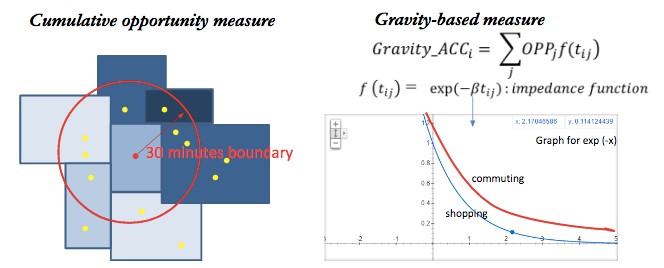News | Transportation PhDs Share Dissertation Research
Stop the VideoNews

by By Sarahi Ortega, MPL 2017
On Wednesday, April 12, 2017, METRANS showcased the research of two USC PhD candidates in Urban Planning and Development as part of the METRANS Research Seminar Series.
Sanggyun Kang presented his research, “Warehouse Location Choice: A case study in Los Angeles, CA,” an evaluation of the changes in warehouse location choice factors. Eun Jin Shin’s research, “Disparities in Access to Opportunities across neighborhood Types: Evidence from the Los Angeles Region,” focused on analyzing the access to opportunities across neighborhoods.
Kang researched the decentralization of warehouses from urban centers to the peripheries of Los Angeles. He focused on large warehouses because they decentralized significantly more than smaller ones. He explained that this might be a problem because trucks will travel more miles if warehouses are further from the urban center and this creates more negative environmental impacts. Kang first looked at the factors that logistics operators take into account when they make location decisions for their warehousing facilities. Then, he evaluated the changes in location with location attributes (choice factors) that affected it.
One of the examples Kang used to illustrate the difference in location choices among various warehousing facilities was that of OnTrac Package Delivery, which provides last mile/instant delivery services, in Commerce, CA. Kang pointed out that this location has direct access to labor pool and local markets of ten million populations, as well as rich transportation infrastructure at their site. Another example is the Ikea distribution center in Lebec, CA that covers the entire US southwest market. This location – lower land rents; direct access to interstate highways; and favorable environments for warehousing operations – fulfills the logistics objectives of the company. His results show that there have been considerable differences that have influenced location choices in terms of the size and built year of a facility. Moreover, the facilities built after 2000 have prioritized lower land rents over access to labor pool and local markets. Kang acknowledged that warehousing data is limited and that there is a large research gap in this topic. Kang’s research will contribute to understanding the location factors involved in various time periods and various types of warehousing facilities.
Eun Jin Shin examined opportunities across different neighborhoods in Los Angeles. Shin is interested in the disparities in accessibility throughout neighborhoods in Los Angeles. She used Southern California Association of Governments (SCAG) 2008 travel time matrices data for each travel mode and 2008-2012 American Community Survey data for neighborhood categorizations. She used two measures, a cumulative opportunity measure and a gravity-based measure. A cumulative opportunity counts the number of opportunities that fell within the travel time frame of 30 minutes, regardless of travel mode. Shin also used a gravity-based measure which placed more weight on opportunities that are closer. At the seminar, Yilin Zhang, a Master of Planning student, asked Shin, “Is there a difference between the two types of test?” Shin answered in the affirmative.

Image Source: Eun Jin Shin’s PowerPoint
Shin used neighborhood type as the main independent variable. She classified the Traffic Analysis Zones (TAZ) into 10 types of neighborhoods based on the characteristics of median household income and racial composition. She divided low-income/middle to high-income neighborhoods into five categories by racial composition—Asian, Hispanic, Black, White, and racially mixed. Shin examined the following opportunity types: total job, low-wage jobs,
mid-wage jobs, high-wage jobs, schools, parks, health care, grocery stores, retail, and entertainment. She determined that low-income ethnic neighborhoods (regardless of travel mode) have better access to both work and non-work opportunities than the reference neighborhoods. However, she also found that ethnic neighborhoods are heterogeneous in terms of their accessibility levels. Shin recognized that there are limitations to her research such as the fact that her study only measures for the quantity of opportunities and not the quality of these opportunities. For example, a neighborhood may offer many grocery stores, but these may be low-quality corner stores.
About the author
Sarahi Ortega is a Master of Planning student in the Price School of Public Policy at the University of Southern California. She can be reached at [email protected] or on LinkedIn.
?
News Archive
- December (1)
- November (6)
- October (4)
- September (2)
- August (3)
- July (4)
- June (3)
- May (7)
- April (8)
- March (11)
- February (8)
- January (7)
- December (7)
- November (8)
- October (11)
- September (11)
- August (4)
- July (10)
- June (9)
- May (2)
- April (12)
- March (8)
- February (7)
- January (11)
- December (11)
- November (5)
- October (16)
- September (7)
- August (5)
- July (13)
- June (5)
- May (5)
- April (7)
- March (5)
- February (3)
- January (4)
- December (4)
- November (5)
- October (5)
- September (4)
- August (4)
- July (6)
- June (8)
- May (4)
- April (6)
- March (6)
- February (7)
- January (7)
- December (8)
- November (8)
- October (8)
- September (15)
- August (5)
- July (6)
- June (7)
- May (5)
- April (8)
- March (7)
- February (10)
- January (12)















